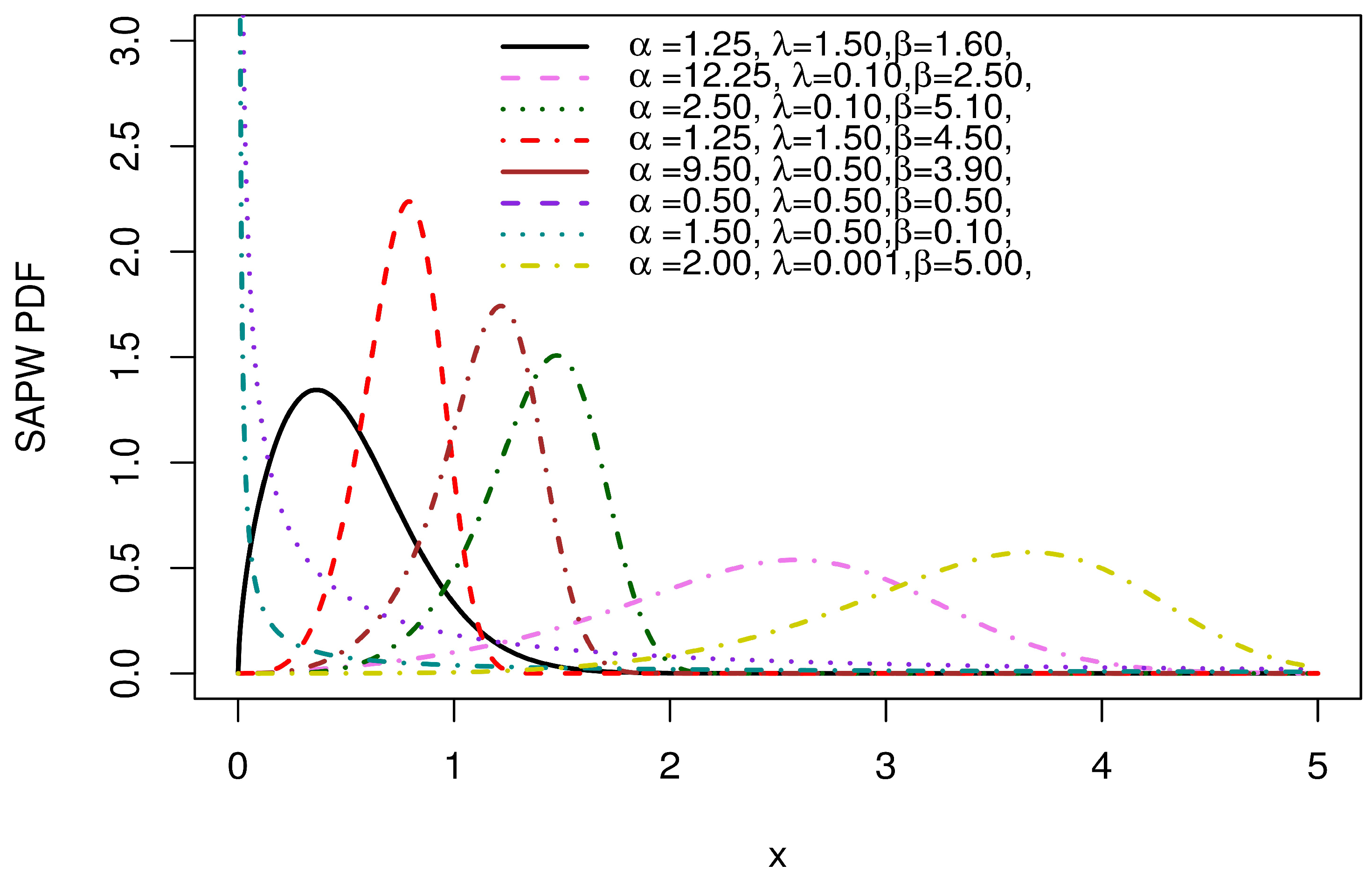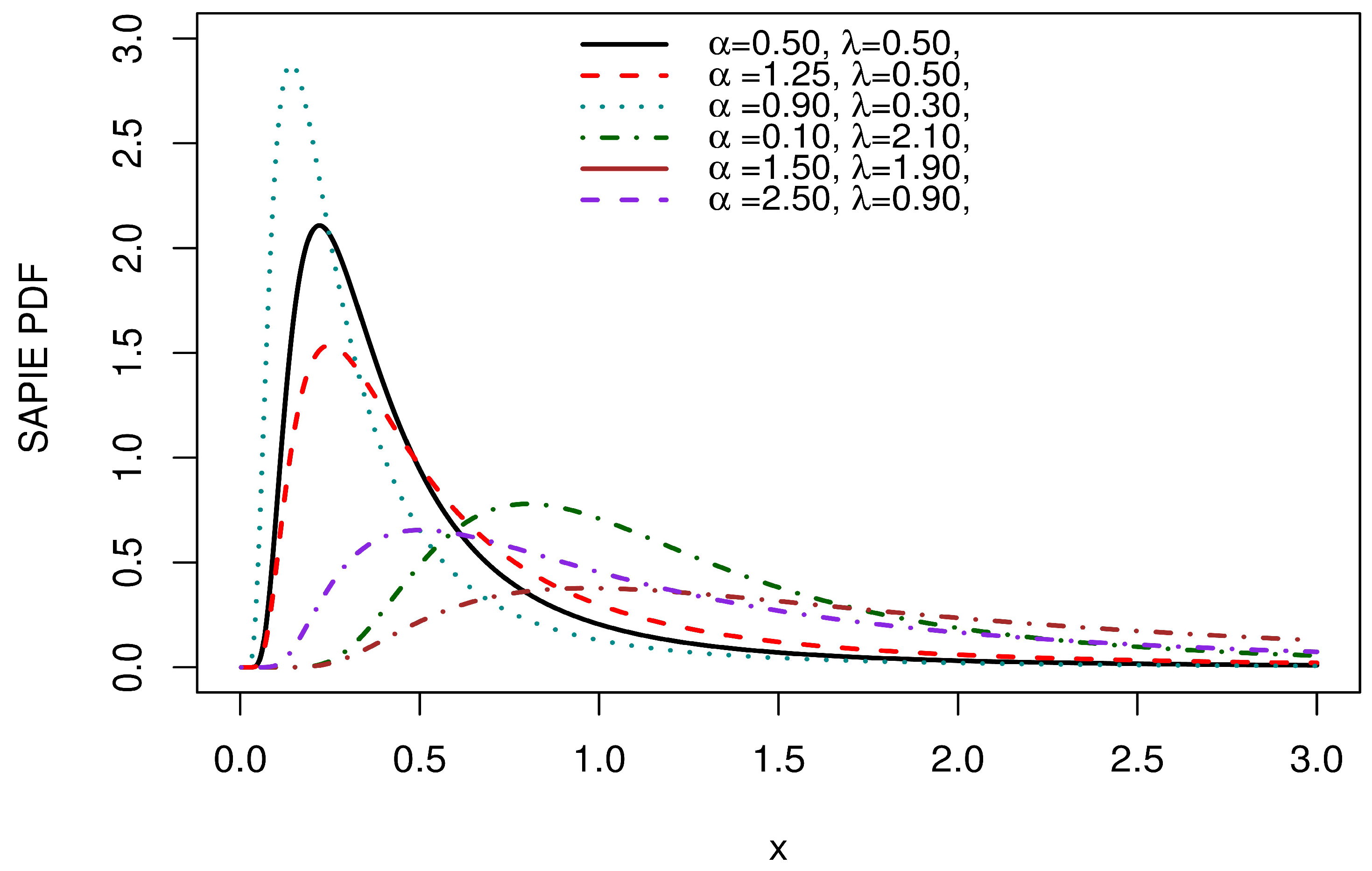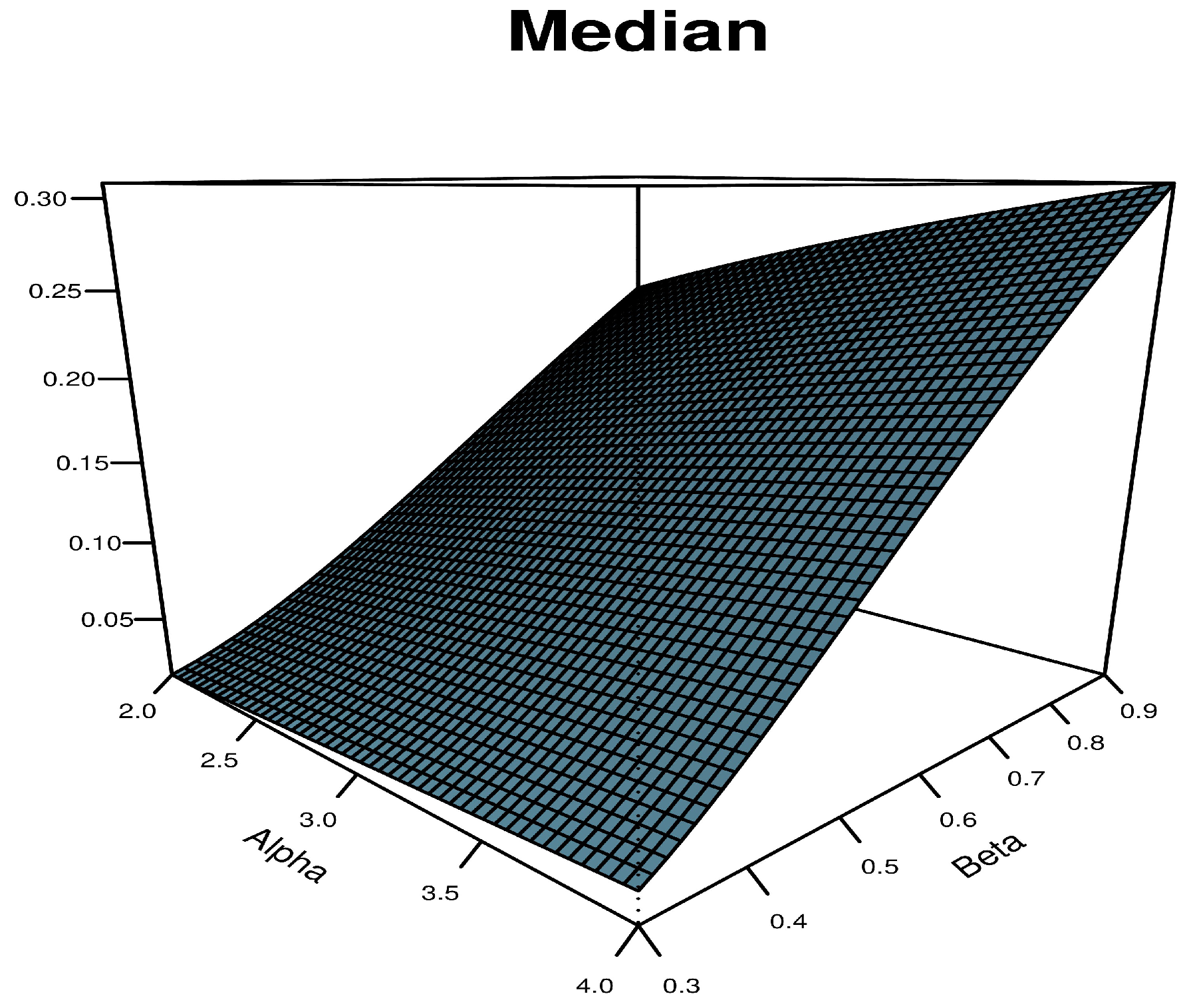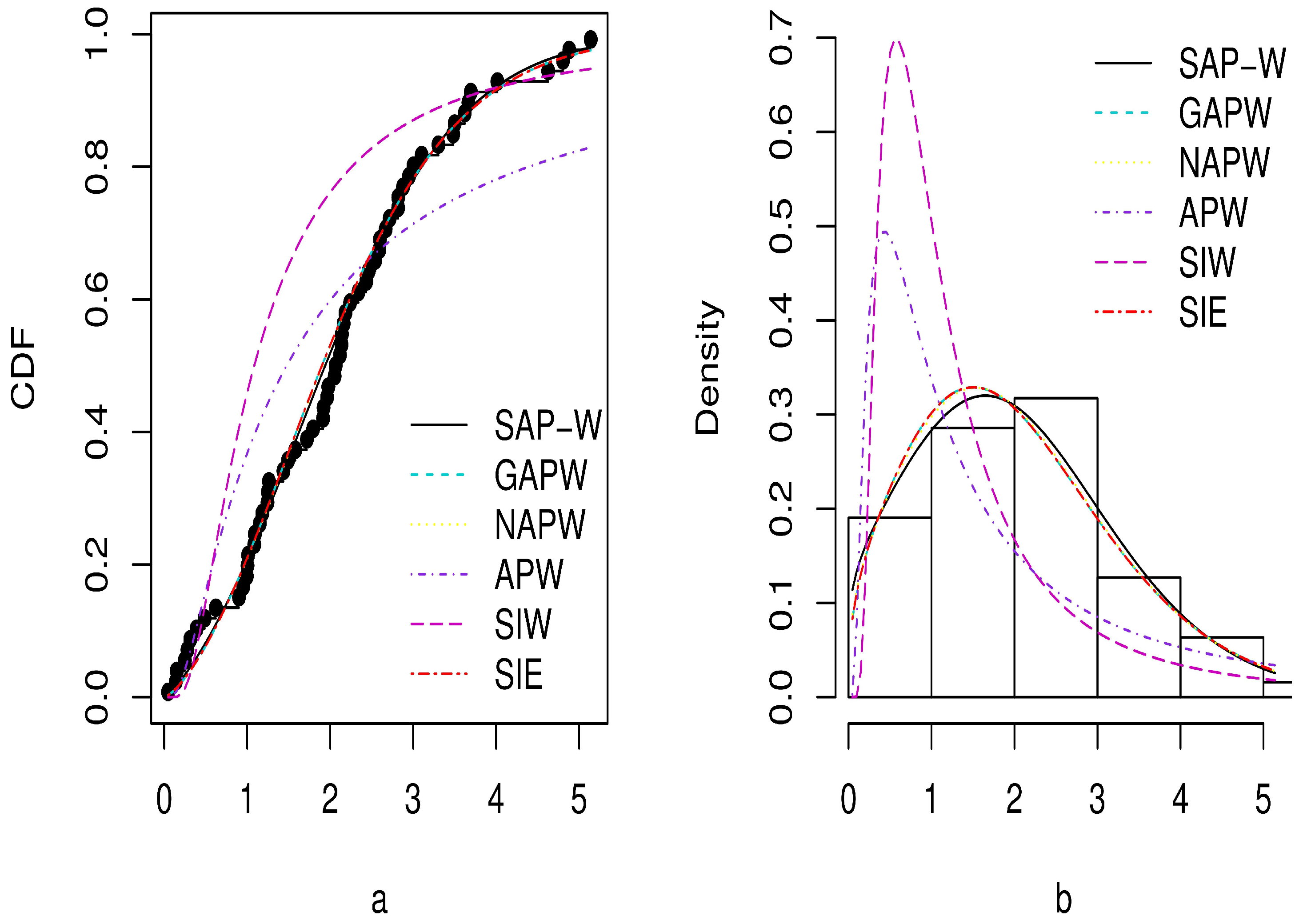The Sine Alpha Power-G Family of Distributions: Characterizations, Regression Modeling, and Applications
Abstract
:1. Introduction
- Create new models with significant graphical and mathematical features.
- Expand the classical distributions by adding only one parameter instead of two or more.
- Create family submodels that possess only one additional parameter, circumventing issues related to over-parameterization.
- Include the trigonometric function, which increases the flexibility of the submodels, resulting in new and more adaptable models.
- Contribute to the existing literature on trigonometric families by presenting a novel family of distributions that can enhance the adaptability of already existing distributions with the ideal number of parameters.
2. The Sine Alpha Power Generated Family
2.1. Members of the SAP-G Family
2.1.1. Sine Alpha Power Weibull Distribution
2.1.2. Sine Alpha Power Exponential Distribution
2.1.3. Sine Alpha Power Inverse Exponential Distribution
2.1.4. Sine Alpha Power Fréchet Distribution
2.1.5. Sine Alpha Power Burr XII Distribution
3. The Sine Alpha Power-Weibull Distribution
3.1. Expansion for the SAP-W Density
3.2. The SAP-W Quantile and Median
3.3. Skewness and Kurtosis
3.4. Moments
3.5. SAP-W Moment Generating and Characteristic Functions
3.6. Rényi Entropies
3.7. Order Statistics
4. Parameter Estimation
5. Simulation Study
6. Applications
- Data 1: Breaking stress of carbon fibers.
- These real data are obtained from [28] and include 100 observations. The data are as follows:
- 3.7, 2.74, 2.73, 2.5, 3.6, 3.11, 3.27, 2.87, 1.47, 3.11, 4.42, 2.41, 3.19, 3.22, 1.69, 3.28, 3.09, 1.87, 3.15, 4.9, 3.75, 2.43, 2.95, 2.97, 3.39, 2.96, 2.53, 2.67, 2.93, 3.22, 3.39, 2.81, 4.2, 3.33, 2.55, 3.31, 3.31, 2.85, 2.56, 3.56, 3.15, 2.35, 2.55, 2.59, 2.38, 2.81, 2.77, 2.17, 2.83, 1.92, 1.41, 3.68, 2.97, 1.36, 0.98, 2.76, 4.91, 3.68, 1.84, 1.59, 3.19, 1.57, 0.81, 5.56, 1.73, 1.59, 2, 1.22, 1.12, 1.71, 2.17, 1.17, 5.08, 2.48, 1.18, 3.51, 2.17, 1.69, 1.25, 4.38, 1.84, 0.39, 3.68, 2.48, 0.85, 1.61, 2.79, 4.7, 2.03, 1.8, 1.57, 1.08, 2.03, 1.61, 2.12, 1.89, 2.88, 2.82, 2.05, 3.65.
- Data 2: Electrical Appliance Failure Data.
- These data are provided by [29] and refer to the number of 1000s of cycles of failure for electrical appliances in a life test, given as follows:
- 0.014, 0.034, 0.059, 0.061, 0.069, 0.080, 0.123, 0.142, 0.165, 0.210, 0.381, 0.464, 0.479, 0.556, 0.574, 0.839, 0.917, 0.969, 0.991, 1.064, 1.088, 1.091, 1.174, 1.270, 1.275, 1.355, 1.397, 1.477, 1.578, 1.649, 1.702, 1.893, 1.932, 2.001, 2.161, 2.292, 2.326, 2.337, 2.628, 2.785, 2.811, 2.886, 2.993, 3.122, 3.248,3.715, 3.790, 3.857, 3.912, 4.100, 4.106, 4.116, 4.315, 4.510, 4.580, 5.267, 5.299, 5.583, 6.065, 9.701.
- Data 3: Aircraft windshields.
- These data present the service times of 63 aircraft windshields measured in 1000 h, given in [30]. The data are as follows:
- 0.046, 1.436, 2.592, 0.140, 1.492, 2.600, 0.150, 1.580, 2.670, 0.248, 1.719, 2.717, 0.280, 1.794, 2.819, 0.313, 1.915, 2.820, 0.389, 1.920, 2.878, 0.487, 1.963, 2.950, 0.622, 1.978, 3.003, 0.900, 2.053, 3.102, 0.952, 2.065, 3.304, 0.996, 2.117, 3.483, 1.003, 2.137, 3.500, 1.010, 2.141, 3.622, 1.085, 2.163, 3.665, 1.092, 2.183, 3.695, 1.152, 2.240, 4.015, 1.183, 2.341, 4.628, 1.244, 2.435, 4.806, 1.249, 2.464, 4.881, 1.262, 2.543, 5.140.
7. The Log SAP-W Regression Model
7.1. Maximum Likelihood Estimation of the LSAP-W Regression Model
7.2. Applications for the LSAP-W Regression Model
- , survival time;
- , log survival time;
- statusi, censoring indication (0 = censoring, 1 = lifetime);
- , white blood cell characteristics test (0 = negative, 1 = positive);
- , white blood cell count.
8. Conclusions
Author Contributions
Funding
Data Availability Statement
Conflicts of Interest
References
- Gupta, R.C.; Gupta, P.L.; Gupta, R.D. Modeling failure time data by Lehman alternatives. Commun. Stat.-Theory Methods 1998, 27, 887–904. [Google Scholar] [CrossRef]
- Alzaatreh, A.; Lee, C.; Famoye, F. A new method for generating families of continuous distributions. Metron 2013, 71, 63–79. [Google Scholar] [CrossRef]
- Mahdavi, A.; Kundu, D. A new method for generating distributions with an application to exponential distribution. Commun. Stat.-Theory Methods. 2017, 46, 6543–6557. [Google Scholar] [CrossRef]
- Nassar, M.; Alzaatreh, A.; Mead, M.; Abo-Kasem, O. Alpha power Weibull distribution: Properties and applications. Commun. Stat.-Theory Methods 2017, 46, 10236–10252. [Google Scholar] [CrossRef]
- Ihtisham, S.; Khalil, A.; Manzoor, S.; Khan, S.A.; Ali, A. Alpha-Power Pareto distribution: Its properties and applications. PLoS ONE 2019, 14, e0218027. [Google Scholar] [CrossRef] [PubMed]
- Nasiru, S.; Mwita, P.N.; Ngesa, O. Alpha power transformed Fréchet distribution. Appl. Math. Inf. Sci. 2019, 13, 129–141. [Google Scholar] [CrossRef]
- Ibrahim, G.M.; Hassan, A.S.; Almetwally, E.M.; Almongy, H.M. Parameter estimation of alpha power inverted Topp–Leone distribution with applications. Intell. Autom. Soft Comput. 2021, 29, 353–371. [Google Scholar] [CrossRef]
- Isa, A.M.; Doguwa, S.I.; Alhaji, B.B.; Dikko, H.G. Sine Type II Topp-Leone G Family of Probability Distribution: Mathematical Properties and Application. Arid Zone J. Basic Appl. Res. 2023, 2, 124–138. [Google Scholar] [CrossRef]
- Nanga, S.; Nasiru, S.; Dioggban, J. Cosine Topp–Leone family of distributions:Properties and Regression. Res. Math. 2023, 10, 2208935. [Google Scholar] [CrossRef]
- Kumar, D.; Singh, U.; Singh, S.K. A new distribution using sine function-its application to bladder cancer patients data. J. Stat. Appl. Prob. 2015, 4, 417–427. [Google Scholar]
- Souza, L. New Trigonometric Classes of Probabilistic Distributions. Ph.D. Thesis, Universidade Federal Rural de Pernambuco, Recife, Brazil, 2015. [Google Scholar]
- Souza, L.; Junior, W.R.O.; de Brito, C.C.R.; Chesneau, C.; Ferreira, T.A.E.; Soares, L. General properties for the Cos-G class of distributions with applications. Eurasian Bull. Math. 2019, 2, 63–79. [Google Scholar]
- Souza, L.; Junior, W.R.O.; de Brito, C.C.R.; Chesneau, C.; Fernandes, R.L.; Ferreira, T.A.E. Tan-G class of trigonometric distributions and its applications. Cubo 2021, 23, 1–20. [Google Scholar]
- Souza, L.; de Oliveira, W.R.; de Brito, C.C.R.; Chesneau, C.; Fernandes, R.; Ferreira, T.A.E. Sec-G class of distributions: Properties and applications. Symmetry 2022, 14, 299–323. [Google Scholar] [CrossRef]
- Al-Babtain, A.A.; Elbatal, I.; Chesneau, C.; Elgarhy, M. Sine Topp-Leone-G family of distributions: Theory and applications. Open Phys. 2020, 18, 574–593. [Google Scholar]
- Chesneau, C.; Jamal, F. The sine Kumaraswamy-G family of distributions. J. Math. Ext. 2020, 15, 1–33. [Google Scholar]
- Alkhairy, I.; Nagy, M.; Muse, A.H.; Hussam, E. The Arctan-X family of distributions: Properties, simulation, and applications to actuarial sciences. Complexity 2021, 2021, 4689010. [Google Scholar]
- Alyami, S.A.; Elbatal, I.; Alotaibi, N.; Almetwally, E.M.; Elgarhy, M. Modeling to factor productivity of the United Kingdom food Chain: Using a new lifetime-generated family of distributions. Sustainability 2022, 14, 8942–8969. [Google Scholar] [CrossRef]
- Elgarhy, M.; Alsadat, N.; Hassan, A.S.; Chesneau, C. Bayesian inference using MCMC algorithm of sine truncated Lomax distribution with application. AIP Adv. 2023, 13, 095120. [Google Scholar]
- Mahmood, Z.; Jawa, T.M.; Sayed-Ahmed, N.; Khalil, E.; Muse, A.H.; Tolba, A.H. An extended cosine generalized family of distributions for reliability modeling: Characteristics and applications with simulation study. Math. Probl. Eng. 2022, 2022, 3634698. [Google Scholar] [CrossRef]
- Hassanein, W.A.; Elhaddad, T.A. Simulating phenomena with exponentiated trigonometric distributions: A comparative study of estimation methods and real-world applications. Stoch. Environ. Res. Risk Assess. 2024, 38, 777–792. [Google Scholar]
- Nanga, S.; Sayibu, S.B.; Angbing, I.D.; Alhassan, M.; Benson, A.; Abubakari, A.G.; Nasiru, S. Secant Kumaraswamy Family of Distributions: Properties, Regression Model, and Applications. Comput. Math. Methods 2024, 2024, 8925329. [Google Scholar] [CrossRef]
- Abonongo, J. Properties and applications of the Tan Weibull loss distribution. Kuwait J. Sci. 2025, 52, 100304. [Google Scholar] [CrossRef]
- Ahmad, A.; Rather, A.A.; Gemeay, A.M.; Nagy, M.; Sapkota, L.P.; Mansi, A.H. Novel sin-G class of distributions with an illustration of Lomax distribution: Properties and data analysis. AIP Adv. 2024, 14, 035132. [Google Scholar] [CrossRef]
- Rahman, H. Exponentiated Arctan-X Family of Distribution: Properties, Simulation and Applications to Insurance Data. Thail. Stat. 2025, 23, 199–216. [Google Scholar]
- Benchiha, S.; Sapkota, L.P.; Al Mutairi, A.; Kumar, V.; Khashab, R.H.; Gemeay, A.M.; Elgarhy, M.; Nassr, S.G. A new sine family of generalized distributions: Statistical inference with applications. Math. Comput. Appl. 2023, 28, 83. [Google Scholar] [CrossRef]
- Moors, J. A quantile alternative for kurtosis. J. R. Stat. Soc. Ser. D (Stat.) 1988, 37, 25–32. [Google Scholar] [CrossRef]
- Nichols, M.D.; Padgett, W.J. A bootstrap control chart for Weibull percentiles. Qual. Reliab. Eng. Int. 2006, 22, 141–151. [Google Scholar] [CrossRef]
- lawless, J.F. Statistical Models and Methods for Lifetime Data; John Wiley & Sons: Hoboken, NJ, USA, 2011. [Google Scholar]
- Blischke, W.R.; Murthy, D.N.P. Reliability: Modeling, Prediction, and Optimization; John Wiley & Sons: Hoboken, NJ, USA, 2011. [Google Scholar]
- Ijaz, M.; Asim, S.M.; Alamgir; Farooq, M.; Khan, S.A.; Manzoor, S. A Gull Alpha Power Weibull distribution with applications to real and simulated data. PLoS ONE 2020, 15, e0233080. [Google Scholar] [CrossRef]
- Elbatal, I.; Ahmad, Z.; Elgarhy, M.; Almarashi, A.M. A new alpha power transformed family of distributions: Properties and applications to the Weibull model. J. Nonlinear Sci. Appl. 2018, 12, 1–20. [Google Scholar] [CrossRef]
- Shrahili, M.; Elbatal, I.; Almutiry, W.; Elgarhy, M. Estimation of sine inverse exponential model under censored schemes. J. Math. 2021, 2021, 7330385. [Google Scholar] [CrossRef]
- Hashimoto, E.M.; Ortega, E.M.; Cordeiro, G.M.; Hamedani, G. The log-gamma-logistic regression model: Estimation, sensibility and residual analysis. J. Stat. Theory Appl. 2017, 16, 547–564. [Google Scholar] [CrossRef]
- Korkmaz, M.C.; Altun, E.; Yousof, H.M.; Hamedani, G.G. The odd power Lindley generator of probability distributions: Properties, characterizations and regression modeling. Int. J. Stat. Probab. 2019, 8, 70–89. [Google Scholar] [CrossRef]
- Baharith, L.A.; Al-Beladi, K.M.; Klakattawi, H.S. The Odds exponential-pareto IV distribution: Regression model and application. Entropy 2020, 22, 497. [Google Scholar] [CrossRef]
- Cordeiro, G.M.; Tahir, M.H.; Vasconcelos, J.C.S.; Ortega, E.M.M.; Hussain, M.A. A new extended log-Weibull regression: Simulations and applications. Hacet. J. Math. Stat. 2021, 50, 855–871. [Google Scholar] [CrossRef]











| Set I | Set II | Set III | Set IV | ||||||
|---|---|---|---|---|---|---|---|---|---|
| Parameter | MLEs | MSE | MLEs | MSE | MLEs | MSE | MLEs | MSE | |
| n = 15 | 12.3790 | 118.3521 | 11.7114 | 104.2730 | 12.1073 | 116.7967 | 0.0022 | 0.0008 | |
| 3.9083 | 3.6416 | 5.0854 | 6.6844 | 3.8257 | 3.7082 | 1.1634 | 0.0267 | ||
| 1.4036 | 0.0414 | 1.7717 | 0.0738 | 1.0395 | 0.0195 | 0.7478 | 0.0614 | ||
| n = 25 | 10.8435 | 87.3019 | 10.8927 | 88.2224 | 10.5554 | 85.6629 | 0.0014 | 0.0008 | |
| 2.9422 | 0.8877 | 3.5750 | 1.1557 | 2.8931 | 0.9862 | 0.5792 | 0.1770 | ||
| 1.0462 | 0.0237 | 1.3069 | 0.0373 | 0.7766 | 0.0152 | 0.5390 | 0.0015 | ||
| n = 50 | 5.3361 | 14.7160 | 5.3192 | 14.5862 | 5.1764 | 15.0266 | 0.0016 | 0.0008 | |
| 2.7141 | 0.5100 | 3.3378 | 0.7019 | 2.6624 | 0.5813 | 0.5919 | 0.1665 | ||
| 1.1140 | 0.0074 | 1.3931 | 0.0114 | 0.8274 | 0.0053 | 0.5287 | 0.0008 | ||
| n = 100 | 1.6996 | 0.0398 | 1.7004 | 0.0402 | 1.6076 | 0.0946 | 0.0038 | 0.0007 | |
| 2.4340 | 0.1883 | 3.0867 | 0.3442 | 2.3648 | 0.2160 | 0.7599 | 0.0576 | ||
| 1.2773 | 0.0060 | 1.5966 | 0.0093 | 0.9503 | 0.0025 | 0.5260 | 0.0007 | ||
| n = 200 | 1.5326 | 0.0011 | 1.5314 | 0.0010 | 1.3209 | 0.0004 | 0.0232 | 0.0001 | |
| 1.9429 | 0.0033 | 2.4410 | 0.0035 | 1.8410 | 0.0035 | 0.9034 | 0.0093 | ||
| 1.2281 | 0.0008 | 1.5354 | 0.0012 | 0.9213 | 0.0005 | 0.5100 | 0.0001 |
| Data | Size | Mean | Median | Min. | Max. | First Quartile | Third Quartile |
|---|---|---|---|---|---|---|---|
| 1 | 100 | 2.621 | 2.700 | 0.390 | 5.560 | 1.840 | 3.220 |
| 2 | 60 | 2.193 | 1.676 | 0.014 | 9.701 | 0.773 | 3.365 |
| 3 | 63 | 2.085 | 2.065 | 0.046 | 5.140 | 1.122 | 2.820 |
| Distribution | Parameter | MLEs and SE in () | ||
|---|---|---|---|---|
| Data 1 | Data 2 | Data 3 | ||
| SAP-W | 0.2030 (0.3808) | 6.0303 (7.7353 ) | 10.0078 (14.3150) | |
| 0.0140 (0.0111) | 0.5347 (0.2505) | 0.4196 (0.2354) | ||
| 2.8962 (0.2389) | 0.7882 (0.1644) | 1.1880 (0.2745) | ||
| GAPW | 2.1148 (0.8315) | 0.5427 (0.3674) | 0.4108 (0.3250) | |
| 3.1049 (0.2437) | 0.8906 (0.1539 ) | 1.3714 (0.2527) | ||
| 0.0190 (0.0091) | 0.6539 (0.2433) | 0.4602 (0.2085) | ||
| NAPW | 0.4749 (0.1889) | 1.8425 (1.2472) | 2.4342 (1.9259) | |
| 0.0191 (0.0093) | 0.6538 (0.2433) | 0.4602 (0.2085) | ||
| 3.1050 (0.2426) | 0.8906 (0.1539) | 1.3713 (0.2527) | ||
| APW | 0.1687 (0.3910) | 3.6821 (4.3293) | 5.9036 (7.4776) | |
| 0.0182 (0.0195) | 0.7011 (0.2734) | 0.5054 (0.2356) | ||
| 3.1896 (0.3659) | 0.8702 (0.1581) | 1.3327 (0.2567) | ||
| SIW | 3.7887 (0.3477) | 1.1300 (0.1159) | 1.4278 (0.1364) | |
| 1.4625 (0.0930) | 0.4646 (0.0397) | 0.6732 (0.0537) | ||
| SIE | 2.8243 (0.2151) | 0.4577 (0.0435) | 1.1914 (0.1108) |
| Distribution | AIC | BIC | CAIC | K-S | p-Values | |
|---|---|---|---|---|---|---|
| SAP-W | 141.1779 | 288.3559 | 296.1714 | 292.2636 | 0.0634 | 0.8165 |
| GAPW | 141.1785 | 288.3569 | 296.1724 | 292.2647 | 0.0686 | 0.7340 |
| NAPW | 141.1788 | 288.3576 | 296.1731 | 292.2654 | 0.0687 | 0.7320 |
| APW | 141.3403 | 288.6807 | 296.4962 | 292.5884 | 0.0697 | 0.7159 |
| SIW | 161.5795 | 327.159 | 332.3694 | 329.7642 | 0.1358 | 0.0501 |
| SIE | 174.6757 | 351.3514 | 353.9566 | 352.6540 | 0.2460 | 1.113 × |
| Distribution | AIC | BIC | CAIC | K-S | p-Values | |
|---|---|---|---|---|---|---|
| SAP-W | 105.9299 | 217.8598 | 224.1428 | 221.0013 | 0.0741 | 0.8723 |
| GAPW | 106.6183 | 219.2366 | 225.5197 | 222.3782 | 0.0779 | 0.8315 |
| NAPW | 106.6183 | 219.2366 | 225.5197 | 222.3782 | 0.0779 | 0.8315 |
| APW | 106.5183 | 219.0365 | 225.3195 | 222.1780 | 0.0777 | 0.8343 |
| SIW | 123.7684 | 251.5369 | 255.7256 | 253.6312 | 0.1990 | 0.0147 |
| SIE | 200.5836 | 403.1671 | 405.2615 | 404.2143 | 0.5488 | 6.661 × |
| Distribution | AIC | BIC | CAIC | K-S | p-Values | |
|---|---|---|---|---|---|---|
| SAP-W | 98.77106 | 203.5421 | 209.9715 | 206.7568 | 0.0796 | 0.7894 |
| GAPW | 99.5222 | 205.0444 | 211.4738 | 208.2591 | 0.0920 | 0.6275 |
| NAPW | 99.5222 | 205.0444 | 211.4738 | 208.2591 | 0.0920 | 0.6274 |
| APW | 99.3842 | 204.7685 | 211.1979 | 207.9832 | 0.0891 | 0.6655 |
| SIW | 123.2494 | 250.4987 | 254.7850 | 252.6419 | 0.1927 | 0.0160 |
| SIE | 141.3209 | 284.6417 | 286.7848 | 285.7133 | 0.3341 | 9.019 × |
| Distribution | MLEs and SE in () | |||||
|---|---|---|---|---|---|---|
| LSAP-W | = 4.1176 | = 1.2498 | = −0.0101 | = 1.2581 | = 0.5824 | - |
| (1.2267) | (0.4754) | (0.0068) | (0.2662) | (1.5388) | ||
| LCTLW | = 0.0931 | = 1.0486 | = −0.0199 | = 3.5675 | = 3.5090 | - |
| (1.6652) | (0.5857) | (0.0089) | (1.1407) | (1.9604) | ||
| LOEPIV | = 3.9730 | = 1.2059 | = −0.0072 | = 1.4393 | = 2.2448 | = 0.5503 |
| (3.9760) | (0.4248) | (0.0055) | (0.5434) | (4.0538) | (0.6096) | |
| LMOOLLW | = 5.4702 | = 1.4642 | = −0.0193 | = 12.8771 | a = 10.9912 | b = 10.4342 |
| (10.1283) | (0.4988) | (0.0099) | (26.0700) | (23.8519) | (42.9320) |
| Distribution | AIC | BIC | CAIC | HQC |
|---|---|---|---|---|
| LSAP-W | 122.0415 | 129.524 | 134.524 | 124.5591 |
| LCTLW | 122.0807 | 129.5632 | 134.5632 | 124.5983 |
| LOEPIV | 124.3900 | 133.3691 | 139.3691 | 127.4112 |
| LMOOLLW | 123.6568 | 132.6359 | 138.6359 | 126.6780 |
Disclaimer/Publisher’s Note: The statements, opinions and data contained in all publications are solely those of the individual author(s) and contributor(s) and not of MDPI and/or the editor(s). MDPI and/or the editor(s) disclaim responsibility for any injury to people or property resulting from any ideas, methods, instructions or products referred to in the content. |
© 2025 by the authors. Licensee MDPI, Basel, Switzerland. This article is an open access article distributed under the terms and conditions of the Creative Commons Attribution (CC BY) license (https://creativecommons.org/licenses/by/4.0/).
Share and Cite
Alghamdi, A.S.; ALoufi, S.F.; Baharith, L.A. The Sine Alpha Power-G Family of Distributions: Characterizations, Regression Modeling, and Applications. Symmetry 2025, 17, 468. https://doi.org/10.3390/sym17030468
Alghamdi AS, ALoufi SF, Baharith LA. The Sine Alpha Power-G Family of Distributions: Characterizations, Regression Modeling, and Applications. Symmetry. 2025; 17(3):468. https://doi.org/10.3390/sym17030468
Chicago/Turabian StyleAlghamdi, Amani S., Shatha F. ALoufi, and Lamya A. Baharith. 2025. "The Sine Alpha Power-G Family of Distributions: Characterizations, Regression Modeling, and Applications" Symmetry 17, no. 3: 468. https://doi.org/10.3390/sym17030468
APA StyleAlghamdi, A. S., ALoufi, S. F., & Baharith, L. A. (2025). The Sine Alpha Power-G Family of Distributions: Characterizations, Regression Modeling, and Applications. Symmetry, 17(3), 468. https://doi.org/10.3390/sym17030468






